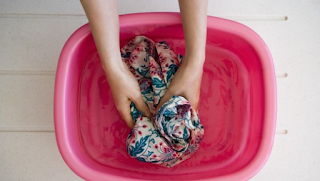Anyone who has dropped off dress shirts at the Dry Cleaners like Comet Cleaners in Denton Texas knows a little bit about starch. They know there's the option of no starch, light starch, medium starch, heavy starch and extra heavy starch (Cowboy Starch). What kind of starch do you choose? There are both pros and cons to starching clothing, and not all clothing will react to being starched in the same way.
What is it?
Starch is a carbohydrate produced by all green plants as a source of energy. It is used in the Dry Cleaning industry as a stiffener for fabrics. There are three different types of starch that are used in a commercial laundry; corn starch, wheat starch, and synthetic starch.
 |
Corn Starch is a natural starch derived from the endosperm of the corn kernel. It's fine texture in powder form make a paste when mixed with water. This natural 'glue' sticks to the fibers of your shirt offering resistance against wrinkles when worn. It is a water soluble starch and will eventually wash out of your shirts. The drawback of corn starch is that the particles are rather small and a large percentage of starch added to the clothing is rinsed away in the rinse cycle. |
 |
Wheat starch is also a natural starch that has a "glue-like" consistency. It is the starch of choice for most commercial cleaners who use natural starch since it sticks to fibers better than corn starch. Since the particles are larger microscopically, they are able to be caught and entwined in the fibers of the shirt with less being wasted in the rinse cycle. |
 |
Synthetic Starch, also known as poly vinyl chloride or PVC is basically a plastic polymer. The particles are larger, like wheat, so they stick well to the fibers and less rinses away. During pressing of the shirt, heat is applied to the fabric which melts the PVC and bonds it semi-permanently to the fibers. This encases the fibers with a layer of plastic and keeps the individual fibers extremely rigid. This is fantastic for a crisp looking shirt that resists wrinkles well. It does wash out over time. Synthetic starches can also be made from a combination of difference natural starches with added plasticizers. |
Why Use it?
Starch is added in different amounts to different types of fabrics. Slight variances in fabric content, size of the individual strands, and even the type of weave can have an effect on how a particular shirt looks and feels after being starched. There are pros and cons to starch usage:
Pros:
- Leaves a crisp, clean appearance to dress shirts
- Makes ironing easier
- Helps resist stains
- Some may find starched clothing itchy and scratchy
- May reduce the lifespan of clothing by stiffening fibers. When fibers come into contact with anything else, they offer more resistance and can fray or break.
- Know what type of starch is currently being used on your clothes.
- Do not over starch shirts if you intend to keep them in usable condition for a while.
- Starch of any kind will coat the individual strands of a shirt. Dark shirts do not respond well to starches and will begin to develop a "shine" if overly saturated.


























